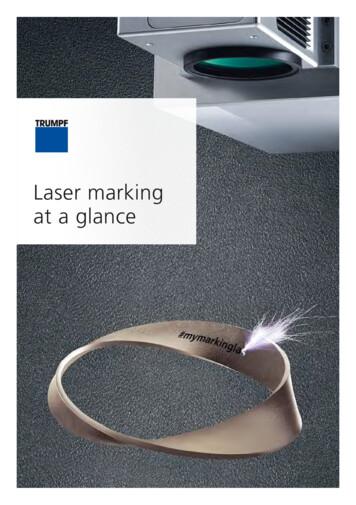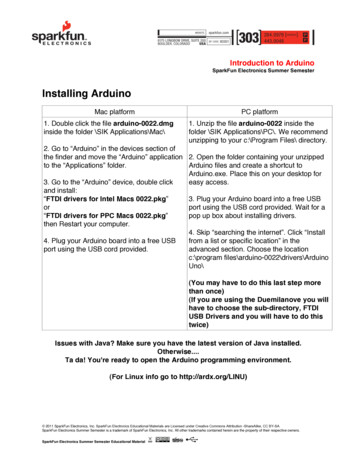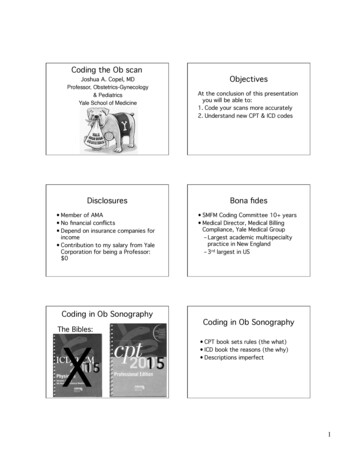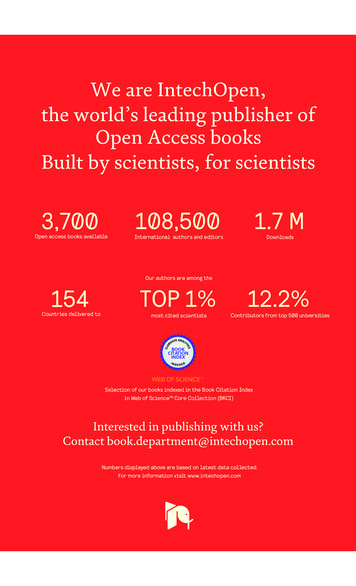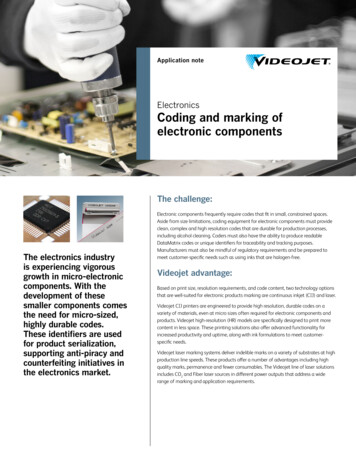
Transcription
Application noteElectronicsCoding and marking ofelectronic componentsThe challenge:The electronics industryis experiencing vigorousgrowth in micro-electroniccomponents. With thedevelopment of thesesmaller components comesthe need for micro-sized,highly durable codes.These identifiers are usedfor product serialization,supporting anti-piracy andcounterfeiting initiatives inthe electronics market.Electronic components frequently require codes that fit in small, constrained spaces.Aside from size limitations, coding equipment for electronic components must provideclean, complex and high resolution codes that are durable for production processes,including alcohol cleaning. Coders must also have the ability to produce readableDataMatrix codes or unique identifiers for traceability and tracking purposes.Manufacturers must also be mindful of regulatory requirements and be prepared tomeet customer-specific needs such as using inks that are halogen-free.Videojet advantage:Based on print size, resolution requirements, and code content, two technology optionsthat are well-suited for electronic products marking are continuous inkjet (CIJ) and laser.Videojet CIJ printers are engineered to provide high resolution, durable codes on avariety of materials, even at micro sizes often required for electronic components andproducts. Videojet high-resolution (HR) models are specifically designed to print morecontent in less space. These printing solutions also offer advanced functionality forincreased productivity and uptime, along with ink formulations to meet customerspecific needs.Videojet laser marking systems deliver indelible marks on a variety of substrates at highproduction line speeds. These products offer a number of advantages including highquality marks, permanence and fewer consumables. The Videojet line of laser solutionsincludes CO2 and Fiber laser sources in different power outputs that address a widerange of marking and application requirements.
The benefitsof codingWhy coding mattersSmart coding for anti-counterfeitingComponent identificationCoding and marking technology can provide a whole new level of visibility andtracking to the distribution channel. Utilizing smart coding solutions can helpmanufacturers build a stronger foundation in support of existing distributiontracking initiatives and anti-diversion efforts. They can also help provideincreased visibility towards protecting product brands and profitability.Many electronic components look exactly the same. In manycases, the outer look is the same, and only the internal circuitrychanges. Coding allows differentiation between components andmanufacturers.Brand identification and recognitionMost electronic components are sold in bulk directly tomanufacturers. Only a small fraction is sold with individualpackaging. In many cases, coding is the only opportunity theelectronic component manufacturer has to identify its productand to represent its brand to its users.Traceability and counterfeitingAside from providing track and trace visibility of productthroughout the distribution chain, codes can also be an integralmeans of fighting counterfeit products. A common challenge formanufacturers is the illegal copying and sale of electroniccomponents that look like very similar to the original device.Products manufactured with counterfeit components canintroduce serious risk to the reliability and warranty of the device.Moreover, such components can even get the productmanufacturer in trouble with regulators, as the counterfeitcomponent has not been certified for use in the final product.With smart coding technology, manufacturers can add uniqueproduct identifiers which help to make counterfeiting moredifficult.2Smart coding techniques include enhancing basic lot/batch codes by alteringand verifying specific characters in your codes. Algorithmic softwaretechnology helps manufacturers make their codes more difficult forunauthorized parties to replicate. It is also possible to generate unique singleitem product codes for individual products on the line.
Smart codingtechnologySmart CodingTechniqueWhat it isHow it worksSelf-verifyingcodesThese codes follow a pre-determined rule or patternsuch as the digits adding up to a specific number orcertain digits that are multiples of one another.A basic way to provide your supply chain partners with avisual check to confirm that products are genuine.InterleavedmarkingTwo or more programmatically selected characterswithin an alphanumeric code partially overlap.Only accomplished with custom software on both the printerand controller, interleaved marking provides additional codeprotection because it is easily viewed but is difficult to replicate.Dynamicallyaltered fontSoftware generated codes with small segments of adifferent letter or number missing to create uniquecodes on each product.Subtle and therefore difficult to recognize by an untrainedeye, dynamically altered fonts can still be visually inspectedby supply chain partners to prove authenticity of a product.VerifiablecodeCodes created by unique software-driven algorithmsthat can be scanned and tracked with vision systemsthroughout the supply chain.Impossible to replicate without knowledge of the algorithmand keys, verifiable codes add a unique fingerprint to eachitem.3
Coding challengesConsiderations for successful codingComplex codes, small spacesWith computer circuitry being incorporated in everyday devices like light bulbs,watches, shoes, etc., the space required to print long, complex codesis shrinking. This is especially true in the electronics industry where DataMatrixcodes are so widely used to track products throughout the distribution chain.Durability for production processesA key step in electronic components manufacturing is the cleaning of the PCB and/or product with organic solvents to remove, among other things, solder residue.Codes need to be able to survive this cleaning process, while not affecting theelectronic component.Legislative complianceTo stay competitive and be compliant in the global marketplace, electroniccomponent manufacturers must meet current and evolving legislationrequirements. ROhS legislation, for example, started in the EU, but has influencedthe establishment of similar regulations around the globe. These regulations banthe use of certain hazardous substances like lead, mercury, cadmium, hexavalentchromium, and polybrominated flame retardants in products4
Solutions for electronicsmarkingBased on print size and resolution requirements, two technology options well-suitedfor electronics marking are laser and continuous inkjet.LaserContinuous inkjet (CIJ)Lasers are known for producing clean, consistent, high quality codes – from simple lot andbatch detail to more complex graphics, including DataMatrix codes. Low maintenance andversatile in high speed and high automation environments, lasers are also ideal forgenerating permanent, traceable codes on electronic components.A good choice for electronic components coding,CIJ printers can produce high quality codes,including DataMatrix codes, as small as 0.6mm.Videojet has high-resolution (HR) models specificallyengineered for micro print applications. Theyprovide a viable option for low-to-medium ormedium-to-high volume producers and offer ease ofintegration into existing production equipment.As part of the marking process, a laser beam changes or ablates the surface properties ofthe component being marked, creating a high resolution, high contrast code. Since lasermarking is not ink-based, codes are not affected by organic solvent cleaners.There are several methods that lasers utilize to make a mark. The ideal method for eachapplication will depend on the sensitivity of the material being marked. Advanced laserscan offer larger marking fields that can mark multiple parts without reorienting the laser orthe tray of components. By optimizing marking fields and laser power settings,manufacturers can improve output and minimize energy use.Not all laser marking systems are equal, and expertise can go a long way in helping specifyan ideal laser for each application. It is recommended that manufacturers work with acoding partner that offers a large selection of laser configurations. This helps enablemanufacturers to more easily identify and integrate an optimal solution for their needs,and not over-purchase more than is required for the application.Permanent laser lot/batch codes can help to protect product integrity throughout thesupply chain. Smart coding technology can help manufacturers move beyond basic lot/batch code data by making it possible to alter and verify specific characters in a code. Thisprocess makes it more difficult for unauthorized parties to duplicate and pirate products.Fast-drying, CIJ inks can accommodate a range ofproduction speeds and application requirements.This printing technology is non-contact and will notdamage or compromise the surface of the part andis ideal for very thin components (e.g. LCD screens,battery packs) that could be adversely affected by alaser marking solution. And for manufacturingprocesses requiring them, durable, alcohol-resistantor halogen-free inks are available. With lowmaintenance requirements, manufacturers can helpmaximize the uptime of their production lines with aCIJ coding solution.Galvo motorsLaserGalvo mirror:x-axisGalvo mirror:y-axisScan lensProduct5
ConclusionCoding technology can provide many benefits for electronic componentsmanufacturers, including product identification, branding and traceability. Thelatest laser and CIJ printer offerings can provide outstanding resolution, printdurability and the ability to generate complex codes, even in small spaces. Videojetoffers a wide range of solutions to meet your varied production needs, includingspecialty inks and printers that meet RoHs compliance requirements. As anindustry leader, we strive to understand the needs of your business as well as yourmanufacturing processes. This expertise helps us to partner with you to identifyyour ideal coding solution and then assist with seamless integration into your line.The bottom lineWith a variety of code considerations to keep inmind and coding technologies to choose from,achieving high quality coding on your electroniccomponents requires thoughtful planning.Videojet offers proven coding solutions forelectronics that address your unique needs. Weare ready to help you think through the idealsolution for your production process.Ask your Videojetrepresentative for moreguidance, a productionline audit, or sampletesting on your substrate.Call 800-843-3610Email info@videojet.comor visit www.videojet.comVideojet Technologies Inc.1500 Mittel Blvd. Wood Dale IL 60191 / USA 2017 Videojet Technologies Inc. — All rights reserved.Videojet Technologies Inc.’s policy is one of continued product improvement.We reserve the right to alter design and/or specifications without notice.Printed in U.S.A.
components. With the development of these smaller components comes the need for micro-sized, highly durable codes. These identifiers are used for product serialization, supporting anti-piracy and counterfeiting initiatives in the electronics market. The challenge: Electronic components freque




